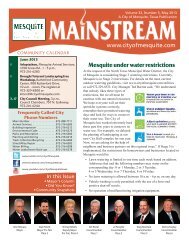airport/documents/Mesquite Master Plan Final.pdf - The City of ...
airport/documents/Mesquite Master Plan Final.pdf - The City of ...
airport/documents/Mesquite Master Plan Final.pdf - The City of ...
You also want an ePaper? Increase the reach of your titles
YUMPU automatically turns print PDFs into web optimized ePapers that Google loves.
landing, but this practice is common if<br />
the <strong>airport</strong> comes within visual range.<br />
Tracking <strong>of</strong> AIAs should become more<br />
accurate with the recent installation <strong>of</strong><br />
the ground communications outlet,<br />
2-28<br />
allowing pilots to communicate with the<br />
Fort/Worth ATCT. <strong>The</strong> forecast<br />
presented in Table 2P utilized an<br />
industry standard <strong>of</strong> two percent <strong>of</strong><br />
itinerant operations to account for AIAs.<br />
TABLE 2P<br />
Annual Instrument Approach (AIAs) Projections<br />
<strong>Mesquite</strong> Metro Airport<br />
Year AIA's Itinerant Operations Ratio<br />
1995 59 20,000 0.30%<br />
1996 17 20,000 0.09%<br />
1997 10 20,000 0.05%<br />
1998 68 20,000 0.34%<br />
1999 143 20,000 0.72%<br />
2000 81 20,000 0.41%<br />
2001 167 20,500 0.81%<br />
2002 228 27,500 0.83%<br />
2003 148 27,969 0.53%<br />
2004 101 28,439 0.36%<br />
FORECASTS<br />
Short Term 1,028 51,400 2.00%<br />
Intermediate Term 1,132 56,600 2.00%<br />
Long Term 1,350 67,500 2.00%<br />
Source: FAA Terminal Area Forecast - Approach Operations<br />
SUMMARY<br />
This chapter has provided demandbased<br />
forecasts <strong>of</strong> aviation activity at<br />
<strong>Mesquite</strong> Metro Airport over the next<br />
20 years. An attempt has been made to<br />
define the projections in terms <strong>of</strong> short,<br />
intermediate and long term<br />
expectations. Elements such as local<br />
socioeconomic indicators, anticipated<br />
regional development and historical<br />
aviation data as well as national<br />
aviation trends were all considered<br />
when determining future conditions.<br />
<strong>The</strong> next step in the master planning<br />
process will be to assess the capacity <strong>of</strong><br />
existing facilities, their ability to meet<br />
forecast demand, and to identify<br />
changes to the airfield and/or landside<br />
facilities which will create a more<br />
functional aviation facility. A summary<br />
<strong>of</strong> aviation forecasts is depicted on<br />
Exhibit 2E.




